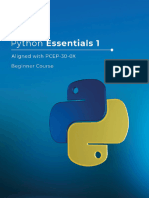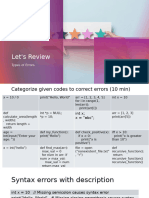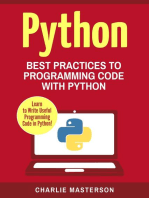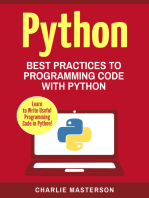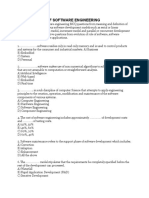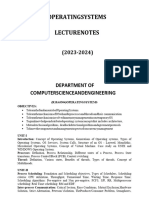Python Tutorial_ Tests, DocTests, UnitTests
Uploaded by
SentinelPython Tutorial_ Tests, DocTests, UnitTests
Uploaded by
SentinelPython Course
Home Python 2 Tutorial Python 3 Tutorial Advanced Topics Numerical Programming Machine Learning Tkinter Tutorial Contact
Previous Chapter: Exception Handling
Next Chapter: Object Oriented Programming
Python Tests
Follow Bernd Klein,
Errors and Tests the author of this
website, at Google+:
Bernd Klein on
Usually, programmers and program developers spend a great deal of their time with debugging and testing. It's hard to give exact percentages, because it highly
depends among other factors on the individual programming style, the problems to be solved and of course on the qualification of a programmer. Of course, the
Python 3 programming language is another important factor.
Tutorial Bernd Klein on
You don't have to program to get pestered by errors, as even the ancient Romans knew. The philosopher Cicero coined more than 2000 years ago an unforgettable
The Origins of aphorism, which is often quoted: "errare humanum est"1
Python This aphorism is often used as an excuse for failure. Even though it's hardly possible to completely eliminate all errors in a software product, we should always work
Search this website:
Starting with ambitiously to this end, i.e. to keep the number of errors minimal.
Python: The
Interactive Shell Go
Executing a Kinds of Errors
This topic in German
Script
/ Deutsche
Indentation There are various kinds of errors. During program development there are lots of "small errors", mostly typos. Whether a colon is missing - for example, behind an
Übersetzung: Tests,
Data Types and "if" or an "else - or the keyword "True" is wrongly written with a lower case "t". These errors are called syntactical errors.2
Doctests, UnitTests
Variables In most cases, syntactical errors can be easily found, but another type of errors is harder to be solved. A semantic error is syntactically correct code, but the program doesn't behave in the intended way. Imagine
Operators somebody wants to increment the value of a variable x by one, but instead of "x += 1" he or she writes "x = 1".
The following longer code example may harbour another semantic error: Python 3
Sequential Data
Types: Lists and x = int(input("x? ")) This is a tutorial in
Strings y = int(input("y? ")) Python3, but this
List chapter of our course
if x > 10:
Manipulations is available in a
if y == x:
Shallow and print("Fine") version for Python
Deep Copy else: 2.x as well: Tests,
print("So what?") DocTests, UnitTests in
Dictionaries
Python 2.x
Sets and Frozen
We can see two if statements. One nested inside of the other. The code is definitely syntactically correct. But it may be, that the writer of the program only wanted to output "So what?", if the value of the variable x
Sets is both greater than 10 and x is not equal to y. In this case, the code should look like this: Classroom
An Extensive
x = int(input("x? "))
Training
Example Using
y = int(input("y? ")) Courses
Sets
input via the if x > 10: The goal of this
keyboard if y == x: website is to provide
Conditional print("Fine")
educational material,
else:
Statements allowing you to learn
print("So what?")
Loops, while Python on your own.
Loop Both code versions are syntactically correct, but one of them violates the intended semantics. Let's look at another example: Nevertheless, it is
For Loops faster and more
>>> for i in range(7): efficient to attend a
Difference
... print(i) "real" Python course
between ... in a classroom, with
interators und 0 an experienced
Iterables 1
trainer. So why not
2
Output with Print attend one of the live
3
Formatted output 4 Python courses in
with string 5 Strasbourg, Paris,
modulo and the 6 Luxembourg,
>>> Amsterdam, Zürich /
format method
Zurich, Vienna /
Functions The statement ran without raising an exception, so we know that it is syntactically correct. Though it is not possible to decide, if the statement is semantically correct, as we don't know the problem. It may be that Wien, London, Berlin,
Recursion and the programmer wanted to output the numbers from 1 to 7, i.e. 1,2,...7 Munich, Hamburg,
Recursive In this case, he or she does not properly understand the range function. Frankfurt, or Lake
Functions Constance by Bernd
Parameter So we can divide semantic errors into two categories. Klein, the author of
Passing in this tutorial?
Errors caused by lack of understanding of a language construct.
Functions
Errors due to logically incorrect code conversion.
Namespaces
Global and Local Onsite Training
Variables Courses
Decorators
Memoization with Unit Tests Let us come to your
company or institute
Decorators
This paragraph is about unit tests. As the name implies they are used for testing units or components of the code, typically, classes or functions. The and train your
Read and Write
underlying concept is to simplify the testing of large programming systems by testing "small" units. To accomplish this the parts of a program have to employees, as we've
Files done it many times in
be isolated into independent testable "units". One can define "unit testing" as a method whereby individual units of source code are tested to
Modular Amsterdam (The
determine if they meet the requirements, i.e. return the expected output for all possible - or defined - input data. A unit can be seen as the smallest
Programming Netherlands), Berlin
testable part of a program, which are often functions or methods from classes. Testing one unit should be independent from the other units. As a unit
and Modules is "quite" small, i.e. manageable to ensure complete correctness. Usually, this is not possible for large scale systems like large software programs or (Germany), Bern
Packages in operating systems. (Switzerland), Basel
Python (Switzerland), Zurich
(Switzerland),
Regular
Locarno
Expressions Module Tests with __name__ (Switzerland), Den
Regular Haag (The Hague),
Expressions, Every module has a name, which is defined in the built-in attribute __name__. Let's assume that we have written a module "xyz" which we have saved Hamburg (Germany),
Advanced as "xyz.py". If we import this module with "import xyz", the string "xyz" will be assigned to __name__. If we call the file xyz.py as a standalone Frankfurt (Germany),
Lambda program, i.e. in the following way, Toronto (Canada),
Operator, Filter, Edmonton (Canada),
$python3 xyz.py
Reduce and Map Munich (Germany),
List Vienna / Wien
the value of __name__ will be the string '__main__'.
(Austria) and many
Comprehension
other cities. We do
Iterators and The following module can be used for calculating fibonacci numbers. But it is not important what the module is doing. We want to demonstrate with it, how it is possible to create a simple module test inside of a
training courses in
Generators module file, - in our case the file "xyz.py", - by using an if statement and checking the value of __name__. We check if the module has been started standalone, in which case the value of __name__ will be
England, Switzerland,
'__main__'. We assume that you save the following code as "fibonacci.py":
Exception Liechtenstein,
Handling """ Fibonacci Module """ Austria, Germany,
Tests, DocTests, France, Belgium, the
UnitTests def fib(n): Netherlands,
""" Calculates the n-th Fibonacci number iteratively """ Luxembourg, Poland,
Object Oriented a, b = 0, 1 UK, Italy and other
Programming for i in range(n):
locations in Europe
Class and a, b = b, a + b
return a and in Canada.
Instance
Attributes def fiblist(n): This way you will get
Properties vs. """ creates a list of Fibonacci numbers up to the n-th generation """ a perfect training up
getters and fib = [0,1] to your needs and it
for i in range(1,n): will be extremely cost
setters
fib += [fib[-1]+fib[-2]]
Inheritance efficient as well.
return fib
Multiple Contact us so we can
define and find the
Inheritance It's possible to test this module manually in the interactive Python shell:
best course
Magic Methods
>>> from fibonacci import fib, fiblist curriculum to meet
and Operator >>> fib(0) your needs, and
Overloading 0 schedule course
OOP, Inheritance >>> fib(1) sessions to be held at
1 your location.
Example
>>> fib(10)
Slots 55
Classes and >>> fiblist(10)
Class Creation [0, 1, 1, 2, 3, 5, 8, 13, 21, 34, 55] Skilled Python
>>> fiblist(-8) Programmers
Road to
[0, 1]
Metaclasses >>> fib(-1)
Metaclasses 0 You are looking for
>>> fib(0.5) experienced Python
Metaclass Use
Traceback (most recent call last): developers or
Case: Count File "", line 1, in programmers? We
Function Calls File "fibonacci.py", line 6, in fib can help you, please
Abstract Classes for i in range(n): contact us.
TypeError: 'float' object cannot be interpreted as an integer
>>>
Quote of the
We can see that the functions make only sense, if the input consists of positive integers. The function fib returns 0 for a negative input and fiblist returns always the list [0,1], if the input is a negative integer. Both Day:
functions raise a TypeError exception, because the range function is not defined for floats.
We can test our module by checking the return values for some characteristic calls to fib() and fiblist(). "Invariably, you'll
To err is human So we can add e.g. the following if statement to our module: find that if the
language is any
if fib(0) == 0 and fib(10) == 55 and fib(50) == 12586269025:
good, your users are
print("Test for the fib function was successful!")
"Errare humanum going to take it to
else:
est, sed perseverare print("The fib function is returning wrong values!") places where you
diabolicum!", which never thought it
means "To err is If our program will be called standalone, we see the following output: would be taken."
human, but to (Guido van Rossum)
persevere in error is $ python3 fibonacci.py
diabolic." This Test for the fib function was successful!
proverb is more than
two thousand years We will deliberately add an error into our code now.
old. It is menat in a
general sense, but it We change the following line Data Protection
fits to computer Declaration
a, b = 0, 1
programming as well.
If you dont't test Data Protection
into
enough, you are Declaration
persevering in errors, a, b = 1, 1
which any large
program is full of. Principally, the function fib is still calculating the Fibonacci values, but fib(n) is returning the Fibonacci value for the argument "n+1" If we call our changed module, we receive this error message:
$ python3 fibonacci.py
The Benefit of
"The fib function is returning wrong values!
Testing
This approach has a crucial disadvantage. If we import the module, we will get output, saying the test was okay. Something we don't want to see, when we import the module.
Edsger W. Dijkstra
wrote "Program >>> import fibonacci
testing can be used Test for the fib function was successful!
to show the presence
of bugs, but never to Apart from being disturbing it is not common practice. Modules should be silent when being imported.
show their absence!"
(in "Notes On Our module should only print out error messages, warnings or other information, if it is started standalone. If it is imported, it should be silent. The solution for this problem consists in using the built-in attribute
Structured __name__ in a conditional statement. If the module is started standalone, the value of this attribute is "__main__". Otherwise the value is the filename of the module without the extension.
Programming, Let's rewrite our module in the above mentioned way:
corollary at the end
""" Fibonacci Module """
of section 3, On The
Reliability of def fib(n):
Mechanisms") """ Calculates the n-th Fibonacci number iteratively """
a, b = 0, 1
Supported by: for i in range(n):
a, b = b, a + b
return a
Python Training
Courses in Toronto, def fiblist(n):
Canada """ creates a list of Fibonacci numbers up to the n-th generation """
fib = [0,1]
for i in range(1,n):
fib += [fib[-1]+fib[-2]]
return fib
if __name__ == "__main__":
if fib(0) == 0 and fib(10) == 55 and fib(50) == 12586269025:
print("Test for the fib function was successful!")
else:
print("The fib function is returning wrong values!")
We have squelched our module now. There will be no messages, if the module is imported.
This is the simplest and widest used method for unit tests. But it is definitely not the best one.
doctest Module
The doctest module is often considered easier to use than the unittest, though the later is more suitable for more complex tests. doctest is a test framework that comes prepackaged with Python. The doctest
module searches for pieces of text that look like interactive Python sessions inside of the documentation parts of a module, and then executes (or reexecutes) the commands of those sessions to verify that they
work exactly as shown, i.e. that the same results can be achieved. In other words: The help text of the module is parsed, for example, python sessions. These examples are run and the results are compared
against the expected value.
Usage of doctest:
To use "doctest" it has to be imported. The part of an interactive Python sessions with the examples and the output has to be copied inside of the docstring the corresponding function.
We demonstrate this way of proceeding with the following simple example. We have slimmed down the previous module, so that only the function fib is left:
import doctest
def fib(n):
""" Calculates the n-th Fibonacci number iteratively """
a, b = 0, 1
for i in range(n):
a, b = b, a + b
return a
We now call this module in an interactive Python shell and do some calculations:
>>> from fibonacci import fib
>>> fib(0)
0
>>> fib(1)
1
>>> fib(10)
55
>>> fib(15)
610
>>>
We copy the complete session of the interactive shell into the docstring of our function. To start the module doctest we have to call the method testmod(), but only if the module is called standalone. The complete
module looks like this now:
import doctest
def fib(n):
"""
Calculates the n-th Fibonacci number iteratively
>>> fib(0)
0
>>> fib(1)
1
>>> fib(10)
55
>>> fib(15)
610
>>>
"""
a, b = 0, 1
for i in range(n):
a, b = b, a + b
return a
if __name__ == "__main__":
doctest.testmod()
If we start our module directly like this
$ python3 fibonacci_doctest.py
we get no output, because everything is okay.
To see how doctest works, if something is wrong, we place an error in our code:
We change again
a, b = 0, 1
into
a, b = 1, 1
Now we get the following, if we start our module:
$ python3 fibonacci_doctest.py
**********************************************************************
File "fibonacci_doctest.py", line 8, in __main__.fib
Failed example:
fib(0)
Expected:
0
Got:
1
**********************************************************************
File "fibonacci_doctest.py", line 12, in __main__.fib
Failed example:
fib(10)
Expected:
55
Got:
89
**********************************************************************
File "fibonacci_doctest.py", line 14, in __main__.fib
Failed example:
fib(15)
Expected:
610
Got:
987
**********************************************************************
1 items had failures:
3 of 4 in __main__.fib
***Test Failed*** 3 failures.
The output depicts all the calls, which return faulty results. We can see the call with the arguments in the line following "Failed example:". We can see the expected value for the argument in the line following
"Expected:". The output shows us the newly calculated value as well. We can find this value behind "Got:"
Test-driven Development (TDD)
In the previous chapters, we tested functions, which we had already been finished. What about testing code you haven't yet written? You think that this is not possible? It is not only possible, it is the underlying
idea of test-driven development. In the extreme case, you define tests before you start coding the actual source code. The program developer writes an automated test case which defines the desired "behaviour" of
a function. This test case will - that's the idea behind the approach - initially fail, because the code has still to be written.
The major problem or difficulty of this approach is the task of writing suitable tests. Naturally, the perfect test would check all possible inputs and validate the output. Of course, this is generally not always feasible.
We have set the return value of the fib function to 0 in the following example:
import doctest
def fib(n):
"""
Calculates the n-th Fibonacci number iteratively
>>> fib(0)
0
>>> fib(1)
1
>>> fib(10)
55
>>> fib(15)
610
>>>
"""
return 0
if __name__ == "__main__":
doctest.testmod()
It hardly needs mentioning that the function returns except for fib(0) only wrong return values:
$ python3 fibonacci_TDD.py
**********************************************************************
File "fibonacci_TDD.py", line 10, in __main__.fib
Failed example:
fib(1)
Expected:
1
Got:
0
**********************************************************************
File "fibonacci_TDD.py", line 12, in __main__.fib
Failed example:
fib(10)
Expected:
55
Got:
0
**********************************************************************
File "fibonacci_TDD.py", line 14, in __main__.fib
Failed example:
fib(15)
Expected:
610
Got:
0
**********************************************************************
1 items had failures:
3 of 4 in __main__.fib
***Test Failed*** 3 failures.
Now we have to keep on writing and changing the code for the function fib until it passes the test.
This test approach is a method of software development, which is called test-driven development.
unittest
The Python module unittest is a unit testing framework, which is based on Erich Gamma's JUnit and Kent Beck's Smalltalk testing framework. The module contains the core framework classes that form the basis of
the test cases and suites (TestCase, TestSuite and so on), and also a text-based utility class for running the tests and reporting the results (TextTestRunner).
The most obvious difference to the module "doctest" consists in the fact that the test cases of the module "unittest" are not defined inside of the module, which has to be tested. The major advantage is clear:
program documentation and test descriptions are separate from each other. The price you have to pay on the other hand consists in an increase of work to create the test cases.
We will use our module fibonacci once more to create a test case with unittest. To this purpose we create a file fibonacci_unittest.py. In this file we have to import unittest and the module which has to be tested, i.e.
fibonacci.
Furthermore, we have to create a class with an arbitrary name - we will call it "FibonacciTest" - which inherits from unittest.TestCase. The test cases are defined in this class by using methods. The name of these
methods is arbitrary, but has to start with test. In our method "testCalculation" we use the method assertEqual from the class TestCase. assertEqual(first, second, msg = None) checks, if expression "first" is equal
to the expression "second". If the two expressions are not equal, msg will be output, if msg is not None.
import unittest
from fibonacci import fib
class FibonacciTest(unittest.TestCase):
def testCalculation(self):
self.assertEqual(fib(0), 0)
self.assertEqual(fib(1), 1)
self.assertEqual(fib(5), 5)
self.assertEqual(fib(10), 55)
self.assertEqual(fib(20), 6765)
if __name__ == "__main__":
unittest.main()
If we call this test case, we get the following output:
$ python3 fibonacci_unittest.py
.
----------------------------------------------------------------------
Ran 1 test in 0.000s
OK
This is usually the desired result, but we are now interested what happens in the error case. Therefore we will create our previous error again. We change again the well known line:
a, b = 0, 1
will be changed in
a, b = 1, 1
Now the test result looks like this:
$ python3 fibonacci_unittest.py
F
======================================================================
FAIL: testCalculation (__main__.FibonacciTest)
----------------------------------------------------------------------
Traceback (most recent call last):
File "fibonacci_unittest.py", line 7, in testCalculation
self.assertEqual(fib(0), 0)
AssertionError: 1 != 0
----------------------------------------------------------------------
Ran 1 test in 0.000s
FAILED (failures=1)
The first statement in testCalculation has created an exception. The other assertEqual calls had not been executed. We correct our error and create a new one. Now all the values will be correct, except if the input
argument is 20:
def fib(n):
""" Iterative Fibonacci Function """
a, b = 0, 1
for i in range(n):
a, b = b, a + b
if n == 20:
a = 42
return a
The output of a test run looks now like this:
$ python3 fibonacci_unittest.py
blabal
F
======================================================================
FAIL: testCalculation (__main__.FibonacciTest)
----------------------------------------------------------------------
Traceback (most recent call last):
File "fibonacci_unittest.py", line 12, in testCalculation
self.assertEqual(fib(20), 6765)
AssertionError: 42 != 6765
----------------------------------------------------------------------
Ran 1 test in 0.000s
FAILED (failures=1)
All the statements of testCalculation have been executed, but we haven't seen any output, because everython was okay:
self.assertEqual(fib(0), 0)
self.assertEqual(fib(1), 1)
self.assertEqual(fib(5), 5)
Methods of the Class TestCase
We now have a closer look at the class TestCase.
Method Meaning
setUp() Hook method for setting up the test fixture before exercising it. This method is called before calling the implemented test methods.
tearDown() Hook method for deconstructing the class fixture after running all tests in the class.
assertEqual(self, first, second, msg=None) The test fails if the two objects are not equal as determined by the '==' operator.
assertAlmostEqual(self, first, second, places=None, msg=None, The test fails if the two objects are unequal as determined by their difference rounded to the given number of decimal places (default 7) and comparing
delta=None)
to zero, or by comparing that the between the two objects is more than the given delta.
Note that decimal places (from zero) are usually not the same as significant digits (measured from the most significant digit).
If the two objects compare equal then they will automatically compare almost equal.
assertCountEqual(self, first, second, msg=None) An unordered sequence comparison asserting that the same elements, regardless of order. If the same element occurs more than once, it verifies that
the elements occur the same number of times.
self.assertEqual(Counter(list(first)), Counter(list(second)))
Example:
[0, 1, 1] and [1, 0, 1] compare equal, because the number of ones and zeroes are the same.
[0, 0, 1] and [0, 1] compare unequal, because zero appears twice in the first list and only once in the second list.
assertDictEqual(self, d1, d2, msg=None) Both arguments are taken as dictionaries and they are checked if they are equal.
assertTrue(self, expr, msg=None) Checks if the expression "expr" is True.
assertGreater(self, a, b, msg=None) Checks, if a > b is True.
assertGreaterEqual(self, a, b, msg=None) Checks if a ≥ b
assertFalse(self, expr, msg=None) Checks if expression "expr" is False.
assertLess(self, a, b, msg=None) Checks if a < b
assertLessEqual(self, a, b, msg=None) Checks if a ≤ b
assertIn(self, member, container, msg=None) Checks if a in b
assertIs(self, expr1, expr2, msg=None) Checks if "a is b"
assertIsInstance(self, obj, cls, msg=None) Checks if isinstance(obj, cls).
assertIsNone(self, obj, msg=None) Checks if "obj is None"
assertIsNot(self, expr1, expr2, msg=None) Checks if "a is not b"
assertIsNotNone(self, obj, msg=None) Checks if obj is not equal to None
assertListEqual(self, list1, list2, msg=None) Lists are checked for equality.
assertMultiLineEqual(self, first, second, msg=None) Assert that two multi-line strings are equal.q
assertNotRegexpMatches(self, text, unexpected_regexp, msg=None) Fails, if the text Text "text" of the regular expression unexpected_regexp matches.
assertTupleEqual(self, tuple1, tuple2, msg=None) Analogous to assertListEqual
We expand our previous example by a setUp and a tearDown method:
import unittest
from fibonacci import fib
class FibonacciTest(unittest.TestCase):
def setUp(self):
self.fib_elems = ( (0,0), (1,1), (2,1), (3,2), (4,3), (5,5) )
print ("setUp executed!")
def testCalculation(self):
for (i,val) in self.fib_elems:
self.assertEqual(fib(i), val)
def tearDown(self):
self.fib_elems = None
print ("tearDown executed!")
if __name__ == "__main__":
unittest.main()
A call returns the following results:
$ python3 fibonacci_unittest2.py
setUp executed!
tearDown executed!
.
----------------------------------------------------------------------
Ran 1 test in 0.000s
OK
Most of the TestCase methods have an optional parameter "msg". It's possible to return an additional description of an error with "msg".
Exercises
1. Exercise:
Can you find a problem in the following code?
import doctest
def fib(n):
""" Calculates the n-th Fibonacci number iteratively
>>> fib(0)
0
>>> fib(1)
1
>>> fib(10)
55
>>> fib(40)
102334155
>>>
"""
if n == 0:
return 0
elif n == 1:
return 1
else:
return fib(n-1) + fib(n-2)
if __name__ == "__main__":
doctest.testmod()
Answer:
The doctest is okay. The problem is the implementation of the fibonacci function. This recursive approach is "highly" inefficient. You need a lot of patience to wait for the termination of the test. The number of hours,
days or weeks depend on your computer.☺
Footnotes:
1The aphorism in full length: "Errare (Errasse) humanum est, sed in errare (errore) perseverare diabolicum." (To err is human, but to persist in it is diabolic")
2In computer science, the syntax of a computer language is the set of rules that defines the combinations of symbols that are considered to be a correctly structured document or fragment in that language. Writing
"if" as "iff" is an example for syntax error, both in programming and in the English language.
Previous Chapter: Exception Handling
Next Chapter: Object Oriented Programming
© 2011 - 2018, Bernd Klein, Bodenseo; Design by Denise Mitchinson adapted for python-course.eu by Bernd Klein
You might also like
- Python Programming For Beginners: Learn The Basics Of Python Programming (Python Crash Course, Programming for Dummies)From EverandPython Programming For Beginners: Learn The Basics Of Python Programming (Python Crash Course, Programming for Dummies)5/5 (1)
- Python Tutorial_ a Tutorial Data Types and VariablesNo ratings yetPython Tutorial_ a Tutorial Data Types and Variables1 page
- Debugging Techniques - Software Design and DevelopmentNo ratings yetDebugging Techniques - Software Design and Development1 page
- Buy ebook Think Python 1st Edition Allen B Downey cheap priceNo ratings yetBuy ebook Think Python 1st Edition Allen B Downey cheap price40 pages
- Bıoınformatıcs and r Programmıng – Second PresentatıonNo ratings yetBıoınformatıcs and r Programmıng – Second Presentatıon31 pages
- Instant download Think Python 1st Edition Allen B. Downey pdf all chapter100% (1)Instant download Think Python 1st Edition Allen B. Downey pdf all chapter41 pages
- (Ebook) Think Python by Allen B. Downey ISBN 9781449330729, 144933072X - Download the ebook today and own the complete content100% (1)(Ebook) Think Python by Allen B. Downey ISBN 9781449330729, 144933072X - Download the ebook today and own the complete content53 pages
- Think Python 1st Edition Allen B. Downey - The newest ebook version is ready, download now to explore100% (2)Think Python 1st Edition Allen B. Downey - The newest ebook version is ready, download now to explore57 pages
- Think Python 1st Edition Allen B. Downey download100% (2)Think Python 1st Edition Allen B. Downey download56 pages
- David Mertz Better Python Code a Guide for Aspiring Experts Early Release Addison Wesley ProfessiNo ratings yetDavid Mertz Better Python Code a Guide for Aspiring Experts Early Release Addison Wesley Professi345 pages
- Singh S. Programming With Python. and Its Applications To Physical Systems 2023100% (1)Singh S. Programming With Python. and Its Applications To Physical Systems 2023363 pages
- Python2 Tutorial_ Extensive Python ExampleNo ratings yetPython2 Tutorial_ Extensive Python Example1 page
- INTRODUCTION to Computational Thinking and ProgrammingNo ratings yetINTRODUCTION to Computational Thinking and Programming25 pages
- Chapter 2.6: Testing and Running A Solution: 2.6 (A) Types of Programming ErrorsNo ratings yetChapter 2.6: Testing and Running A Solution: 2.6 (A) Types of Programming Errors0 pages
- (Ebook) Think Python: How to Think Like a Computer Scientist by Allen B. Downey ISBN 9781491939369, 1491939362 instant download100% (1)(Ebook) Think Python: How to Think Like a Computer Scientist by Allen B. Downey ISBN 9781491939369, 1491939362 instant download50 pages
- 5 Types of Programming Languages - CourseraNo ratings yet5 Types of Programming Languages - Coursera1 page
- Python Tutorial_ Memoization and DecoratorsNo ratings yetPython Tutorial_ Memoization and Decorators1 page
- COMPUTER PROGRAMMING FOR KIDS: An Easy Step-by-Step Guide For Young Programmers To Learn Coding Skills (2022 Crash Course for Newbies)From EverandCOMPUTER PROGRAMMING FOR KIDS: An Easy Step-by-Step Guide For Young Programmers To Learn Coding Skills (2022 Crash Course for Newbies)No ratings yet
- Python for Everyone: A Complete Guide to Coding, Data, and Web Development: Your Guide to the Digital World, #3From EverandPython for Everyone: A Complete Guide to Coding, Data, and Web Development: Your Guide to the Digital World, #3No ratings yet
- Python Programming for Beginners: A guide to Python computer language, computer programming, and learning Python fast!From EverandPython Programming for Beginners: A guide to Python computer language, computer programming, and learning Python fast!5/5 (1)
- Programming for Kids and Beginners: 3-in-1 Masterclass into Python, Apps, and GamesFrom EverandProgramming for Kids and Beginners: 3-in-1 Masterclass into Python, Apps, and GamesNo ratings yet
- PYTHON: Practical Python Programming For Beginners & Experts With Hands-on ProjectFrom EverandPYTHON: Practical Python Programming For Beginners & Experts With Hands-on Project5/5 (4)
- Python: Best Practices to Programming Code with Python: Python Computer Programming, #2From EverandPython: Best Practices to Programming Code with Python: Python Computer Programming, #2No ratings yet
- Python Programming: A Hands-On Guide: Hello World E-books STEM, #1From EverandPython Programming: A Hands-On Guide: Hello World E-books STEM, #1No ratings yet
- Python Tutorial_ Structuring with IndentationNo ratings yetPython Tutorial_ Structuring with Indentation1 page
- Python Tutorial_ Lambda Operator, filter, reduce and mapNo ratings yetPython Tutorial_ Lambda Operator, filter, reduce and map1 page
- Reinforcement+learning+with+AWS+DeepRacer+and+Amazon+SageMaker+RL+-+Pedro+PaezNo ratings yetReinforcement+learning+with+AWS+DeepRacer+and+Amazon+SageMaker+RL+-+Pedro+Paez31 pages
- Python Tutorial_ Dynamically Creating Classes With TypeNo ratings yetPython Tutorial_ Dynamically Creating Classes With Type1 page
- Chapter 3.4 - Data Representation, Structure and Manipulation (Cambridge AL 9691)No ratings yetChapter 3.4 - Data Representation, Structure and Manipulation (Cambridge AL 9691)19 pages
- Instant download Introduction to Python for Econometrics, Statistics and Data Analysis Kevin Sheppard pdf all chapter100% (4)Instant download Introduction to Python for Econometrics, Statistics and Data Analysis Kevin Sheppard pdf all chapter76 pages
- Introduction To Algorithms Flowcharts and PseudocodeNo ratings yetIntroduction To Algorithms Flowcharts and Pseudocode10 pages
- How To Find Floating - Dangling Nets, Pins, IO Ports, and Instances Using Get - DB Commands100% (1)How To Find Floating - Dangling Nets, Pins, IO Ports, and Instances Using Get - DB Commands4 pages
- Traffic Simulation: A Project Report OnNo ratings yetTraffic Simulation: A Project Report On17 pages
- Std12 Computer Paper Set Upto July 2024No ratings yetStd12 Computer Paper Set Upto July 2024170 pages
- Blue Prism Guide To Expanding The SAP Function Library PDFNo ratings yetBlue Prism Guide To Expanding The SAP Function Library PDF14 pages
- JavaScript A Beginner's Guide Fifth Edition John Pollock - The ebook in PDF and DOCX formats is ready for download now100% (1)JavaScript A Beginner's Guide Fifth Edition John Pollock - The ebook in PDF and DOCX formats is ready for download now67 pages
- 300+ TOP Database Management System Questions and Answers 2021No ratings yet300+ TOP Database Management System Questions and Answers 202134 pages
- Web Crawler & Scraper Design and Implementation100% (1)Web Crawler & Scraper Design and Implementation9 pages
- Intermediate Programming (Java) 1: Course Title: Getting Started With Java LanguageNo ratings yetIntermediate Programming (Java) 1: Course Title: Getting Started With Java Language11 pages
- Microprocessor Lab Assignment-9 Name - Kotecha Udit Hitendra Reg. No.-20194057 Group - CS-ANo ratings yetMicroprocessor Lab Assignment-9 Name - Kotecha Udit Hitendra Reg. No.-20194057 Group - CS-A5 pages
